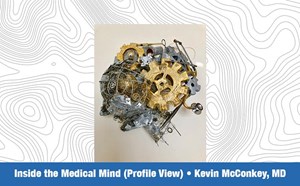Artists Among Us: ACEP's 2021 Annual Report features original art submitted to the 2020 and 2021 HeART of Emergency Medicine Galleries. This photo, “Apical Four Block Art” by Lauren Ann Selame, MD, depicts a standard cardiac ultrasound view, the apical four chamber view. Dr. Selame said: "Recognizable as a heart to many clinicians, others may find abstraction and creatures. In medicine we examine, fix, optimize, and finally surrender to this organ. In life, it guides and mystifies." Medium: Digital Art
Despite the consuming nature of the ongoing pandemic, ACEP members across the country and the world have devoted their time and expertise to other clinical topics that still need attention.
Advocacy that Changes Care
Here are a few ways ACEP’s advocacy efforts are pushing for improved patient care:
- Behavioral Health: House passage of bills to help address ED psychiatric boarding and suicide screening
- Violence: House passage of a broad array of bills to help prevent cyclical violence, domestic abuse, intimate partner violence, and sexual assault
- Firearms Safety: Per College policy, continued supporting bipartisan efforts to expand background checks for firearms purchases
- Opioids: ACEP was a key voice, successfully pushing HHS to waive the burdensome training requirements for receiving the X-waiver
ACEP Calls for Revisions to Sepsis Bundle
In Sept. 2021, ACEP signed on to a letter to the National Quality Forum calling on SEP-1 NOT to be re-endorsed unless it is revised. And in April 2021, the multispecialty task force convened by ACEP in 2019 published its new sepsis guidelines, “Early Care of Adults With Suspected Sepsis in the Emergency Department and Out-of-Hospital Environment: A Consensus-Based Task Force Report” in Annals of Emergency Medicine. The report covers principles of early sepsis recognition, initial care steps in the ED and out-of-hospital environments, titration of care and related controversies. ACEP’s point-of-care tool for sepsis management, DART, has been updated to reflect the guidelines. Learn more.
New Point of Care Tools Developed
The newest version of ACEP’s emPOC app has 12 tools covering the following clinical topics: atrial fibrillation, agitation in the elderly, autism spectrum disorder, hepatic encephalopathy, buprenorphine in the ED, bariatric assessment and management, sepsis, hyperkalemia, and caring for suicidal patients.
- Download the app via Google Play or the App Store.
- Access all point-of-care tools through our website
New PEER Products Help You Prepare
Over the past couple of years, PEER – ACEP’s Board exam study guide – has been upgraded in a big way. Whether you're prepping for the ITE, initial certification exam, ConCert exam, or MyEMCert exam, PEER resources are at the ready. The PEER family now includes:
ACEP Publications Keep You Current
ACEP publications are powered by emergency physicians like you. ACEP members serve as our editors, and many of the articles are penned by EM physicians. When you’re reading ACEP Now, Annals of Emergency Medicine, JACEP Open or Critical Decisions, you’re diving into important clinical and lifestyle conversations happening across the specialty.
Educational Opportunities for All Interests
ACEP is the leading producer of emergency medicine education. Passionate emergency physicians help us develop education that fills knowledge gaps and keeps our specialty on the forefront of clinical practice changes. Behind every conference, course, webinar, podcast, and educational tool, there are ACEP members working together to make it happen.
Committees and Sections Tackle Big Clinical Topics
ACEP has 30 committees and 40 sections working year-round to advance emergency medicine. Here are a few 2021 highlights:
- Ultrasound: A subcommittee of ACEP’s Emergency Ultrasound Section published the new Sonoguide: Ultrasound Guide for Emergency Physicians that includes beginner and advanced concepts.
- Hyperactive Delirium: During the summer of 2020, ACEP heard urgent questions surrounding initial management of hyperactive delirium presenting with severe agitation raised by its membership, the scientific community at large, community leaders, media, and governmental agencies. A task force was appointed to draft a report synthesizing the most current information available regarding the recognition, evaluation, and management of patients in the prehospital or emergency department setting presenting with hyperactive delirium accompanied by severe agitation.
- Geriatric Care: The Geriatric Emergency Medicine Section launched two free online courses that provide a total of five hours of CME credit toward geriatric emergency department accreditation (acep.org/geda). Both courses are available in ACEP’s Online Learning Collaborative.
- Health IT: In spring of 2021, ACEP’s Health Innovation Technology Committee developed resources to help EM physicians navigate the “Open Notes” provision in the 21st Century Cares Act, which made ED notes visible to patients via the electronic health record portal.
- ED Observation and Optimization: The Emergency Medicine Practice Committee revised the following policy statements in 2021.
- “Standardized Protocols for Optimizing Emergency Department Care,”a joint statement with the Emergency Nurses Association (ENA), was updated to remove the term “advanced practice provider” in favor of the more specific terminology “nurse practitioners” and “physician assistants.”
- “Emergency Department Observation Services” policy statement was revised to expand upon scope of practice/supervision, best practices, telehealth, clinical algorithms and continuous quality improvement.
- Clinical Policies: The Clinical Policies Committee published clinical policies related to community-acquired pneumonia and opioids (acep.org/clinicalpolicies) and is also drafting revisions to the appendicitis, acute heart failure syndromes, and mild traumatic brain injury clinical policies.
- EMTALA: The Medical-Legal Committee developed a new webinar series around an oft-requested topic: EMTALA.






